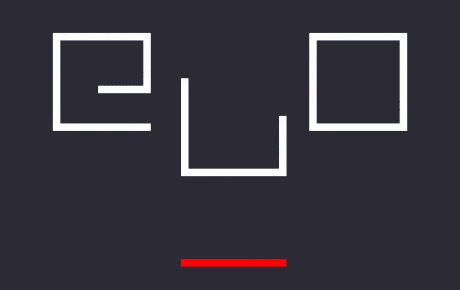The original BUST D0WN THE D00RS! By YOUNG HAE-CHANG HEAVY INDUSTRIES of 2000 combines the fast-paced motion of poetic text phrases with the synchronized rhythm of jazz music to deliver the narrative of an incursion on the narrator’s home by unknown assailants. Although it is unclear as to why the raid occurred and the captors move quickly, the narrator completely disregards the urgency of the situation at hand, with no struggling attempts to avoid impending death; rather, the “traitor” is mesmerized, almost beguiled, by the dream the captors interrupted just moments ago. Initially, the story manifests the second-person perspective, however the story perpetually loops from beginning to end, employing unique perspectives with each following iteration until, eventually, the story loops back to the beginning second-person perspective.
BUST D0WN THE D00RS! applies cinematic aspects feasible using Flash Player to portray looping free-verse poems, differing only in pronouns. The piece opens with a countdown that leads to the presentation of a title screen, similar to those popular with black and white films of the early to mid-twentieth century. Each iteration of the narrative lasts fifty-five seconds, looping back to the beginning with a new perspective, totaling eight unique iterations. The viewer of the piece has no control over the pace of the work once opened, and can only end the perpetual iterations by closing the window. YOUNG HAE-CHANG HEAVY INDUSTRIES omits the implementation of any outstanding visuals or colors by the use of black text on a white background, placing an emphasis on the sensual qualities of the music and motion of the piece instead. The lack of said visuals and color eliminates all distractions from the presentation of the words themselves, forcing the viewer to pay attention to the diversification of perspectives in each loop of the poem, drastically changing the viewer’s understanding of the plot. A segment of Art Blakey’s “Amuck” beats in the background, accentuating the sense of urgency of the narrative in rhythm with the fast-paced motion of the text to further captures the viewer’s undivided attention. YOUNG HAE-CHANG HEAVY INDUSTRIES depends solely on the cinema of the piece, rather than interactive components or additional animation that is usually incorporated in electronic literature to be explored by the reader; therefore, the work’s drama comes from the momentum, the fast-paced drum-march jazz music that speeds through the story, faster and faster as “you” near, or “she” nears, or “we” near death, leaving the viewer fixated on the literature of the story without requiring any manipulation of the piece by the viewer. The pace keeps the viewer from taking time to make sense of it all, while simultaneously inflicting the narrative’s pressures on the viewer so as to make the work truly engaging; ironically, this encourages the viewer to interact with the story as much, or possibly more so, than physically interacting through the use of clicking or scrolling.
Unlike other pieces of electronic literature, YOUNG HAE-CHANG HEAVY INDUSTRIES focuses more on the design and presentation of the work than the plot itself, as works such as BUST D0WN THE D00RS! tend to have multiple perspectives and therefore multiple interpretations; In YOUNG HAE-CHANG HEAVY INDUSTRIES’ BUST D0WN THE D00RS! and other pieces, YOUNG HAE-CHANG HEAVY INDUSTRIES seemingly pioneers the application of cinematic qualities for electronic literature pieces rather than interactive elements. These pieces redefine the advantages of the interactivity that results from the use of an electronic medium for electronic literature; instead of demanding the viewer to navigate through the piece, the piece itself possesses the power to entrance the viewer into exploring the story and capitalizes on the cinematic attributes made possibly by the medium to provide the synergy of the viewer and narrative.







